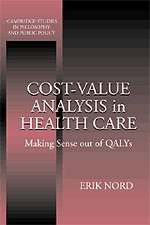Book contents
- Frontmatter
- Contents
- List of Tables and Figures
- Preface and Acknowledgments
- Overview
- Reader's Guide
- 1 Maximizing Value in Health Care
- 2 Three Basic Issues in Economic Evaluation
- 3 QALYs
- 4 Concerns for Fairness
- 5 The Limitations of Utility Measurement
- 6 Ways to Go
- Annex: An Example of Cost-Value Analysis
- References
- Index
- Frontmatter
- Contents
- List of Tables and Figures
- Preface and Acknowledgments
- Overview
- Reader's Guide
- 1 Maximizing Value in Health Care
- 2 Three Basic Issues in Economic Evaluation
- 3 QALYs
- 4 Concerns for Fairness
- 5 The Limitations of Utility Measurement
- 6 Ways to Go
- Annex: An Example of Cost-Value Analysis
- References
- Index
Summary
There is general agreement that a health-care insurance scheme, be it public or private, should not aim to provide all the care its members might want. Rather, it should try to be as valuable as possible to its members, given the resources these members have made available. This is the same as saying that it should give priority to activities that have a favorable ratio between benefits and costs. In that way it will maximize the membership value, hereafter called the societal value, of health care.
A number of approaches are available for estimating the societal value of health interventions at a numerical level. This book focuses on cost-utility analysis, which is a special variant of cost-effectiveness analysis. It uses the concept of a Quality Adjusted Life Year (QALY) to overcome the problem of comparing outcomes that are different in kind. In this approach, any state of illness or disability may be assigned a utility on a scale from zero (the utility assigned to the state of being dead) to unity (the utility assigned to being in full health). The value of a health outcome for an individual is calculated as a product of two factors: the increase in the utility of the person's health state as measured on the 0–1 scale and the number of years the person gets to enjoy this improvement. The measurement of outcomes in terms of QALYs in theory allows for comparisons of cost-effectiveness ratios across all kinds of conditions and interventions and also for the calculation of the total societal value of different health plans.
- Type
- Chapter
- Information
- Cost-Value Analysis in Health CareMaking Sense out of QALYS, pp. xix - xxiiPublisher: Cambridge University PressPrint publication year: 1999

